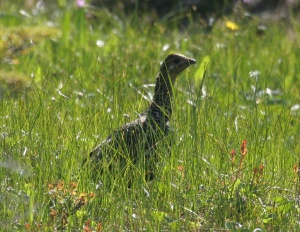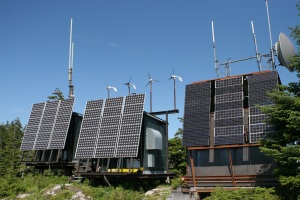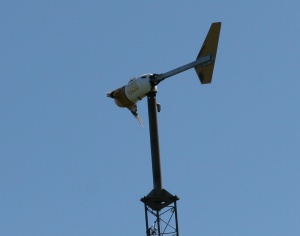

 Share This Page
Share This Page| Home | | Sailing | | Alaska 2006 | |  |  |  Share This Page Share This Page |

Copyright © 2006, P. Lutus. All rights reserved.
(double-click any word to see its definition)





I've found some nice hikes in the Alaska back country. I can't describe them all, there are dozens, some visited only once, some visited every year. This page is about Naked Island, located smack in the middle of Prince William Sound. Naked Island is one of those places that appears to have no attractive features — no salmon rivers, no lodges, no roads or airstrips — so I know if I visit, I'll have it to myself. Also, because of its size and location, there are no bears, so I don't have to constantly be on guard as I walk along. Some of my readers may wonder what I mean when I say I have an island to myself. Is this literally true? Isn't there a ranger, or a pay phone, anywhere on an island like this? How can an entire island, several square miles in size, be uninhabited? All I can say is, this is Alaska, and having a large tract of land to yourself is more the rule than the exception, consequently you must be completely self-reliant. Many places in Alaska are thick with brush — impenetrably so, with no possibility for hikes. Some places can be hiked once you figure out which route to take. I now know how to hike around on Naked Island, but for the life of me I can't imagine why this island has the name it has — it is almost entirely brushy, with a few strips of clear ground, just sufficient to make one's way to a hilltop view. One day this summer I hiked Naked Island, intending to get to a relay station I knew existed but had never managed to find. It was a sunny day with little wind, absolutely beautiful. I rowed my dinghy ashore and made my way to a zone of open tundra, where I hoped to climb to the relay station and get a view of Prince William Sound.Rock Ptarmigan
As I walked from one tundra patch to the next, I met a rock ptarmigan (see pictures this page) and her chicks. I decided to get some pictures of the chicks, who were insufferably cute. Those who have been near these birds know the experience — mama calls out in a distinctive way so the chicks know her location, and the chicks, hiding in the brush, call out in reply. The primary threat to the chicks in this environment is raptors like bald eagles, one of whom was already overhead as I approached. After taking a few pictures I decided to do a somewhat mischievous experiment. I tried making mama ptarmigan's call, and I managed a reasonable imitation. One of the chicks then became completely confused and made a beeline for my shoes, at which point mama flew straight toward me, wings outstretched, trying to put herself between me and her chick. Both arrived at once, between my shoes, mama planting herself over her chick and raising quite a ruckus. I quickly stepped away and resolved not to imitate rock ptarmigan calls any more.Relay Station
I saw this hike as a rare opportunity to achieve a goal I had put to myself several years ago — to visit a relay station I knew was located somewhere in the island's high country. The relay station had little more than symbolic significance, it was just an excuse to climb up high and get a nice view. This hike has been thwarted a number of times over the past few years, mostly by unfavorable weather. But this particular day, the weather was perfect. I climbed along the tundra patches, which fortunately consisted of long, clear strips of open ground that ascended from the southwest. Near the top things became more brushy, but there was sufficient open ground that the hike remained enjoyable. I thought the relay station would be located right on top of the island's central hill, but when I got there, it was nowhere to be seen. I had marked the location using GPS coordinates before leaving the boat, but the charted position turned out to be inaccurate. I walked around in the high country for a while, expecting the relay tower to pop into view over the trees, but without success. Finally I realized I was hearing a distinctly unnatural sound — a generator. I realized there was only one likely source for that sound, so I followed it until I could see the relay station. I certainly didn't expect to find the station by its sound. There is no source of power on Naked Island, so the only way to power the radio equipment at the relay station is to create power locally. The maintainers of this station have done all they can to minimize the cost of operation, by putting up lots of solar panels and windmills. But the fact is these natural power sources aren't adequate, and the primary source of power is a propane-powered generator (which I heard from a distance). Worse, the propane has to be delivered by helicopter. All very expensive. Someone got the idea to install a high-powered windmill, on a tall mast by itself, hoping this would alleviate the power problem and conserve the propane. This sort of approach must seem perfectly sensible until the wind starts to blow. In some unexpected high wind, the high-tech 1500-watt windmill lost its blades (see photo this page).Generating Power
I can't resist another digression. I installed a windmill on my sailboat during my world sail, but I was barely able to keep it under control. It seemed as though the wind was always too strong or too weak. One reason windmills are such a difficult project is that the energy in wind is proportional to the square of wind velocity, so that 20 knots of wind delivers four times as much power as 10 knots. In practice this means windmills spend a lot of time not delivering any power at all, and then, when the wind finally does blow, they will suddenly throw their blades all over the countryside. The solar panels at the relay station seemed adequate to the conditions, but I reminded myself that I was visiting on a sunny summer day, an infrequent occurrence, at a time of year when there is about 20 hours of daylight, a situation that reverses itself in winter. Also, even though the panels were fully illuminated in the summer sun (see picture), the propane generator was running full tilt. I realized this station wanted much more power than it could get from its immediate environment. It was a model for the human race. This was a great hike, and a great day. It was a sunny day in what had been a very wet season, there was little wind, and I found a reasonable hiking route up to a nice view of Prince William Sound, I met a rock ptarmigan family, and I finally saw the relay station.
| Home | | Sailing | | Alaska 2006 | |  |  |  Share This Page Share This Page |